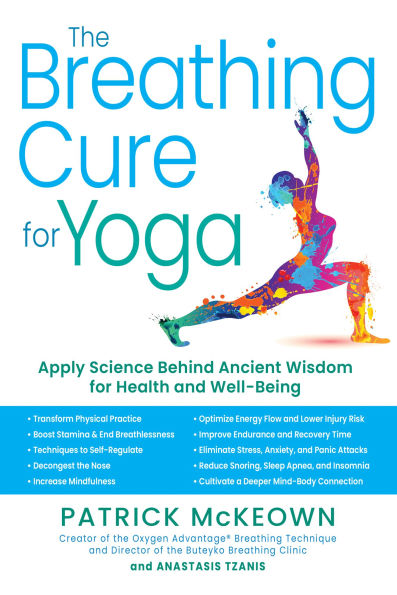READY TO LEARN FROM INTERNATIONAL BREATHING EXPERT PATRICK McKEOWN?
READY TO LEARN FROM LEADING YOGA EDUCATOR ANASTASIS TZANIS?
TAP INTO YOUR FULL YOGA POTENTIAL WITH THE SCIENCE BEHIND ANCIENT WISDOM BY READING THE BREATHING CURE FOR YOGA
With a Foreword by award-winning science journalist James Nestor, New York Times bestselling author of Breath: The New Science of a Lost Art
What if you are only tapping into 75% of the full potential of yoga?
If there was a simple and free way to harness the other 25% and make major improvements in both your asana practice and overall health, would you want to know what it is?
This revolutionary yoga and breathing manual unites modern science, with clinically-proven breathing techniques, and the (mostly) forgotten wisdom of ancient Yogis to enhance your yoga practice. Written by international breath expert Patrick McKeown and leading yoga educator Anastasis Tzanis, this is an essential book for every practitioner and instructor.
In THE BREATHING CURE FOR YOGA: APPLY SCIENCE BEHIND ANCIENT WISDOM FOR HEALTH AND WELL-BEING you will learn how to:
- Enhance your physical practice and lower the risk of injury.
- Learn breathing techniques to self-regulate, gain control over your nervous system, and diminish stress, anxiety, and panic attacks.
- Increase mindfulness and cultivate a deeper mind-body connection.
- Learn the connection between physiology and the mind, and how to optimise gas exchange and open the lungs.
- Reduce breathlessness during yoga, and boost stamina, endurance, and recovery time.
- Learn the three pillars of sleep, breath, and the mind, and their interconnection.
- Optimise energy flow and strengthen your connection to self.
- Dramatically reduce snoring, sleep apnea, and insomnia; decongest the nose; and improve menopause symptoms.
- Enhance your overall health and wellbeing.
READY TO JOING THE REVOLUTION NOW?
Get "Breathing For Yoga" today, and be among the first to benefit from this revolutionary breathing and yoga manual.
“In your hands is the operating manual for new and old yogis alike. For the past 20 years, McKeown has researched why so many of us breathe so poorly and how we can do it better and improve our lives. He’s spent several more years piecing together this carefully constructed compendium of yoga knowledge and distilling it into step-by-step directions, illustrations, scientific context, biomechanics, biochemistry, and more! My advice: Take a seat, shut your mouth, breathe it in.”—James Nestor
READY TO LEARN FROM INTERNATIONAL BREATHING EXPERT PATRICK McKEOWN?
READY TO LEARN FROM LEADING YOGA EDUCATOR ANASTASIS TZANIS?
TAP INTO YOUR FULL YOGA POTENTIAL WITH THE SCIENCE BEHIND ANCIENT WISDOM BY READING THE BREATHING CURE FOR YOGA
With a Foreword by award-winning science journalist James Nestor, New York Times bestselling author of Breath: The New Science of a Lost Art
What if you are only tapping into 75% of the full potential of yoga?
If there was a simple and free way to harness the other 25% and make major improvements in both your asana practice and overall health, would you want to know what it is?
This revolutionary yoga and breathing manual unites modern science, with clinically-proven breathing techniques, and the (mostly) forgotten wisdom of ancient Yogis to enhance your yoga practice. Written by international breath expert Patrick McKeown and leading yoga educator Anastasis Tzanis, this is an essential book for every practitioner and instructor.
In THE BREATHING CURE FOR YOGA: APPLY SCIENCE BEHIND ANCIENT WISDOM FOR HEALTH AND WELL-BEING you will learn how to:
- Enhance your physical practice and lower the risk of injury.
- Learn breathing techniques to self-regulate, gain control over your nervous system, and diminish stress, anxiety, and panic attacks.
- Increase mindfulness and cultivate a deeper mind-body connection.
- Learn the connection between physiology and the mind, and how to optimise gas exchange and open the lungs.
- Reduce breathlessness during yoga, and boost stamina, endurance, and recovery time.
- Learn the three pillars of sleep, breath, and the mind, and their interconnection.
- Optimise energy flow and strengthen your connection to self.
- Dramatically reduce snoring, sleep apnea, and insomnia; decongest the nose; and improve menopause symptoms.
- Enhance your overall health and wellbeing.
READY TO JOING THE REVOLUTION NOW?
Get "Breathing For Yoga" today, and be among the first to benefit from this revolutionary breathing and yoga manual.
“In your hands is the operating manual for new and old yogis alike. For the past 20 years, McKeown has researched why so many of us breathe so poorly and how we can do it better and improve our lives. He’s spent several more years piecing together this carefully constructed compendium of yoga knowledge and distilling it into step-by-step directions, illustrations, scientific context, biomechanics, biochemistry, and more! My advice: Take a seat, shut your mouth, breathe it in.”—James Nestor

The Breathing Cure for Yoga: Apply Science Behind Ancient Wisdom for Health and Well-Being with a Foreword by James Nestor
456
The Breathing Cure for Yoga: Apply Science Behind Ancient Wisdom for Health and Well-Being with a Foreword by James Nestor
456
Product Details
| ISBN-13: | 9781630063047 |
|---|---|
| Publisher: | Humanix Books |
| Publication date: | 12/31/2024 |
| Pages: | 456 |
| Product dimensions: | 6.20(w) x 9.00(h) x 1.20(d) |
